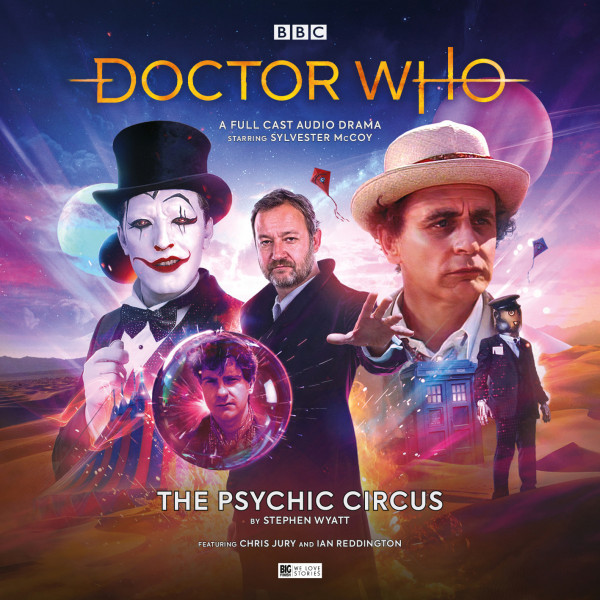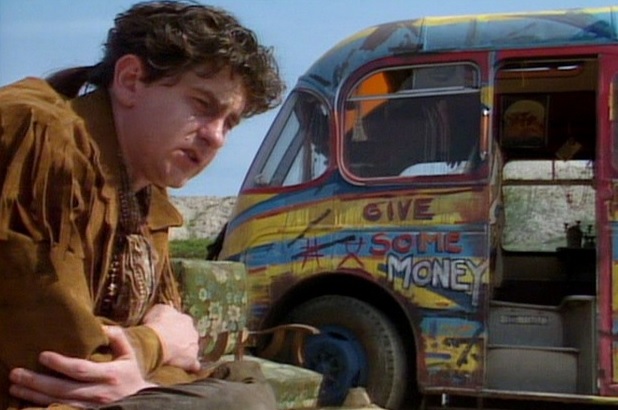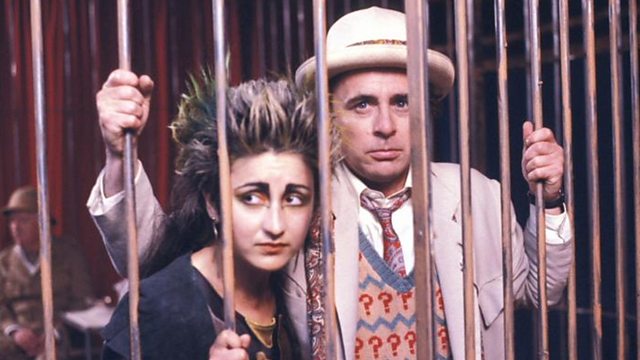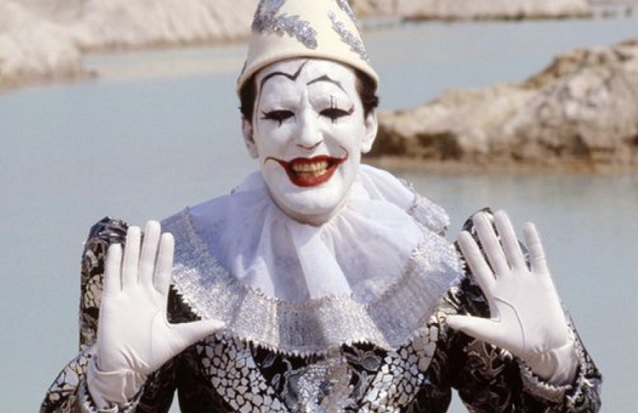To say crime fantasy series Virtual Murder is overlooked is something of an understatement.
Originally aired in 1992, it should technically have become a cult. An ardent fanbase should be obsessing over it, and arguing about every tiny detail on social media. Instead Virtual Murder pretty much came and went. No home media or streaming release. No fan fiction. Just an acknowledgement of its existence and not much else.
For a quirky BBC offering this situation is rather unusual.
You’ll find the odd admirer online. The precious few who like it really seem to like it. Yet virtually no-one’s ridden in to save its reputation over the years. As a stroppy 15 year old I watched Virtual Murder, no doubt snorting derisively throughout. The 46 year old me on the other hand is now a big fan.
I’ve only just rediscovered the show in 2023, the 31st anniversary. Did anyone care about the 30th…?
Virtual Murder falls short of being a stone cold classic. There are a few things wrong here to be fair. Despite that, I believe a resurgence of interest is long overdue. Time to redeem Cornelius and co…
I LOVE YOU DR CORNELIUS
We have two men to thank for the series – creators Harry Robertson and Brian Degas.
Robertson was a high profile musician, who also provided the programme with its strangely compelling soundtrack. Audio-wise, the show is like standing in a lift next to an escaped tiger. Muzak shot through with some hair-raising twists and turns.
Degas meanwhile co-wrote the screenplay for camp space opera Barbarella, among other things. He didn’t contribute a script himself, but Robertson wrote the pilot episode… more on that shortly. Like anything in the Virtual Murder universe, the story is far from straightforward.
Both Robertson and Degas are, sadly, no longer with us. Neither is star Nicholas Clay, or the vast majority of the writers. Notable names on script duty included Philip Martin, who wrote two adventures for Colin Baker’s Doctor Who, not to mention gritty Beeb classic Gangsters. Like Virtual Murder, that show was produced at Pebble Mill Studios in Birmingham.
THE SEXY PSYCHOLOGIST AND HIS “SUPERIOR WOMAN”
Who is Dr John Cornelius? He’s bright, beautiful, middle-aged, wears a duffel coat… and could be a bit of a maniac. He may wax lyrical about human psychology in his lectures, but Cornelius seems to share the same reckless tendencies as those he pursues. The same could be said about the razor sharp and resourceful Samantha Valentine. She’s an aristocrat’s daughter who refers to her partner as “J.C.” Valentine is always ready to prick his pomposity, as well as engage him in a romantic sense.
Clay portrays Cornelius and Valentine is played by Kim Thomson. There isn’t an explanation concerning how the good Doctor became a hunter of wrongdoers, or the circumstances in which he and Samantha met. I guess it wasn’t important, or maybe it was something to be explored in future series. Either way, these are detached, decadent figures who waft about while the real world looks on in awe, or aggravation.
A particularly enjoyable detail for me is the prickly reception Cornelius receives from his colleagues in academia. Sometimes his mere presence is enough to enrage them. They are typically hostile, downright furious at times. He really hasn’t made himself popular during his tenure. And Valentine isn’t above getting on people’s nerves. In one episode she berates a lowly reporter in true “lady of the manor” fashion when he gets in her face.
They’re lovers, yet a fair chunk of tension exists between the main characters. She gets revenge on him over a perceived affair by recording an STD-themed greeting message on his answerphone. Later in the series Cornelius expresses frustration that Valentine is so talented, saying how he hates “a superior woman!”
Rewatching Virtual Murder, I initially found the couple quite annoying and plucky. Then I began enjoying their company, and understanding them better. Clay and Thomson have a wonderfully light touch, bringing us some glimmers of magic at times when events may be a little lacking in quality.
MURDER IN EPISODIC FORMAT
The six stories of Virtual Murder are all quite different. Still, they follow a basic premise, where a “villain of the week” needs to be stopped and only the dynamic duo can catch them. There’s a large amount of creativity at work also.
‘Meltdown to Murder’ by Philip Martin is about a fiendish plot where classic paintings are dissolved in front of people’s eyes. ‘Last Train to Hell and Back’ by Barry Smith (to my knowledge his only screenwriting credit) focuses on a mad judge – played by British film legend Richard Todd – whose obsession with capital punishment may have turned him into a serial killer. ‘A Bone to Pick’ by Tom Needham famously opens with Father Christmas dumping a bag of bones on a policeman’s desk.
‘A Torch for Silverado’ by Tim Aspinall showcases one of Jon Pertwee’s last ever roles. He plays a disgruntled Spanish terrorist targeting the city’s adult establishments. ‘A Dream of Dracula’ by Bennett Byron Sims depicts a modern day version of Bram Stoker’s vintage blood drinker. Then there’s the last episode, ‘Dreams Imagic‘. Or, as it was originally titled, ‘Virtual Murder’.
Why did one episode title take over the whole series? According to TV historian Andrew Pixley, among other sources, the original handle for the show was Nimrod. An old word for “hunter”, it was soon replaced by the more elegant sounding Virtual Murder. The change ultimately didn’t make a lick of sense. There’s nothing virtual about any of the other stories. I like it though… Nimrod sounds like something you’d use to clear out a u-bend.
‘Dreams Imagic’ was actually the pilot, but shown at the end of the run. It stands out, partly for the wrong reasons. Made at a time when VR was just making itself known to the public, the cyberscape is… well, eye opening. By the looks of things, the production team visited a nearby park and then pixelated the heck out of it. We see giant crazy objects in the shape of an octopus and, for some reason, a shoe. Whether these were already part of the location or brought in specially is anyone’s guess.
That said, the effect when victims are blasted out of existence remains impressive. The screen explodes in a gaping, almost organic hole. Not sure how they achieved that! There’s also an accompanying lung-like sound that makes it all rather creepy.
Come to think of it, Virtual Murder has a peculiar breathing element to its theme music. Maybe this was meant to suggest the show’s inherent sexiness!
A CABARET OF CO-STARS
Stephen Yardley takes the part of Inspector Cadogan, presumably intended as the Lestrade to Cornelius’s Holmes. Back then I was familiar with Yardley through his role as oily charmer Ken Masters in Howard’s Way, so it was a surprise to see this enduring TV figure in a trenchcoat and fedora. Cadogan gets a few laughs through his blokey demeanour and somewhat nerdy interests, such as model trains. Accompanying him is Jude Akuwudike as Sgt Gummer. Akuwudike has appeared in hit shows like The A Word, and made an attention-grabbing small screen appearance as Sydney Johnson in The Crown.
Alan David plays Prof Griffiths, a sarcastic and put-upon authority figure who isn’t averse to getting stuck into the action. Assisting Griffiths is Carole Boyd (The Archers) as Phoebe Littlejohn. I wonder if these two got up to their own adventures whilst Cornelius and Valentine were whipping up a storm?
I’ve already mentioned guest stars Richard Todd and Jon Pertwee. Degas and Robertson bagged other British screen icons, with comedians greatly in evidence – Bernard Bresslaw, Dora Bryan and Peggy Mount for starters. The next generation of comedic talent was also represented. Tony Robinson, Julian Clary and Helen Lederer pop up in rare straight roles. A meaty part awaited Enn Reitel, the highly-respected but under the radar character actor. His performance as a diabolical master of disguise transports the series into 1960s Batman territory.
Jill Gascoine, Hywel Bennett and Bottom’s Steven O’Donnell were also on board the train to eccentricity. Virtual Murder employed some rising stars to boot. Sean Pertwee preceded his father, playing a European tech wizard in the pilot. The usually calm and collected Hugh Quarshie turns volcanic as an angry scientist, whose work Cornelius inadvertently disrupts twice in the penultimate episode.
END OF TENURE
Until the return of Doctor Who in 2005, small screen fantasy in Britain was a rare beast. Virtual Murder seemed like a gamble for the BBC, offbeat in tone and dropped into a Friday night slot. The move didn’t pay off. By the time the last episode aired, Cornelius and Valentine’s fate was sealed.
Why did it fail? Speaking purely for myself, Virtual Murder was an old school series that arrived a decade or so too late. If it had happened in the early Eighties, or better still the Seventies, it might have stood a chance. As things stood, the kind of show it reportedly resembled – such as The Avengers – were yesterday’s news.
Academics talking disparagingly about women, double entendres and saucy antics with old comedy stars. This was surely out of place in the Nineties. Bad reviews played a part. Shooting the series on video probably didn’t help. There are an awful lot of novelty wipes used during the production, giving it the feel of some experimental corporate video.
Modern elements underlined the dated approach of the production. Ironically, the virtual reality-themed ‘Dreams Imagic’ was the first episode produced. The other stories were straight out of another era, but in my view worked better. The crime fighting duo with their glamorous lifestyle arguably weren’t cut out for the close of the twentieth century.
NIMROD RISING
In researching this piece I found some reassuringly recent traces of online commentary regarding Virtual Murder, hiding in plain sight. Hopefully my article will give those embers a bit of a blast, enabling the show to blaze back into the public consciousness. Either that or it’ll sit there waiting to be discovered by another obsessive journalist in three decades’ time.
Who knows, maybe some cult TV oriented media entity will revive the format. Hey, they could even ask ME to take the lead writer’s job and…
Someone page Dr Cornelius. I’m having another episode.
If you were involved in the production of Virtual Murder and want to speak to me about it then I’d love to hear from you! You can reach me at: spalace@hotmail.co.uk


































